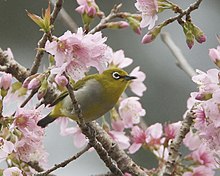|
Prunus cerasoides
Prunus cerasoides, commonly known as the wild Himalayan cherry, sour cherry[4] or pahhiya is a species of deciduous cherry tree in the family Rosaceae. Its range extends in the Himalayas from Himachal Pradesh in north-central India, to south-western China, Burma and Thailand. In India the tree is widely revered in the Himalayan state of Uttarakhand. The tree is found in temperate forest from 1,200–2,400 metres (3,900–7,900 ft) in elevation and extends to tropical highlands of Southeast Asia.[5][6] DescriptionPrunus cerasoides is a tree which grows up to 30 metres (98 ft) in height. It has glossy, ringed bark. When the tree is not in flower, it is characterised by glossy, ringed bark and long, dentate stipules.[citation needed] The tree flowers twice a year, during autumn and spring. First flowering blooms between the months of January to April and second flowering blooms between September to November.[7] Flowers are hermaphroditic and are pinkish white in color. It has ovoid yellow fruit that turns red as it ripens.[citation needed] CultivationPrunus cerasoides thrives in well-drained and moisture-retentive loamy soil, in an open, sunny, and sheltered location.[citation needed] P. cerasoides, like most members of the genus Prunus, is shallow rooted and is likely to produce suckers if the root is damaged. It is likely to become chlorotic if too much lime is present. It is known to be susceptible to honey fungus.[citation needed] The seed requires two to three months cold stratification and is best sown in a cold frame as early in winter as possible. The seed grows rather slowly and can sometimes take about 18 months to germinate depending on the conditions.[citation needed] CultureIn India, Prunus cerasoides is known in Hindi as padam, pajja, pahhiya or padmakashtha has cultural and religious significance.[8][9] Among Hindus in Himachal Pradesh and Uttarakhand, it is considered sacred and associated with Vishnu and Shiva.[10][11][12] During Maha Shivaratri, the leaves are used to make a wreath with wild citrus fruits, which is hung at the prayer altar. They are also seen in Kodaikanal in south India.[13] In Hindi and Sanskrit it is known as padma, padmakh, pajja, pahhiya, padmakashtha, charu, hima, kaidra, padmagandi. In Nepali it is known as paiyu. In Khasi and Mizo languages it is known as dieng kaditusoo and tlaizawng.[14] Prunus cerasoides cherry blossom festivals are held in India during the months of October–November.[15] Shillong is notable for its annual prunus cerasoides cherry blossom festival held during the month of November.[16][17] Religious Significance in Uttarakhand The tree is referred to as “पंय्यां” in the Himalayan State of Uttarakhand, India and is regarded as a holy tree by various groups in both the Garhwal and Kumaon region. The tree is also worshipped exclusively by shilpkars or doms in certain regions of the state. Cerasoides is among the few trees in the region that remain blooming at the height of winters during, December and January and hence is worshipped for its resilience. The tree is traditionally never chopped down in Uttarakhand because of it religious significance, only branches can be cut if there arises a requirement of its leaves, flowers or wood. The Cerasoides is regarded as the tree of the gods in Uttarakhand. Acharya Manu notes "when all the trees drop their leaves during the harsh winter season, flowers grow in the leaves of the tree." The use of its wood in the wedding hall symbolizes strength and happiness in the new life of the bride and groom.[citation needed] Its stalk is also used one way or another in Yajnopaveet, Jagar and Baisi. Among the instruments played in religious programs, Lukudi made of wood of Paiyan tree is considered to be the most sacred. Apart from this, the garlands used in homes during the house warming yajns, yagyopaveet etc. are also made from paiyan leaves. The leaves are also used as incense.[18][19] Village weddings are considered incomplete without having been decorated with the branches and leaves from the tree. Among the instruments played in religious ceremonies, lukudi made from the wood of pahhiya tree is considered to be the most sacred.[10] UsesFood
Other usesThe fruits and the leaves give a dark green dye. Seeds can be used in the manufacture of necklaces. The wood is hard, strong, durable and aromatic, and branches are used as walking sticks. References
External linksWikimedia Commons has media related to Prunus cerasoides. |
||||||||||||||||||||||||||||||||||||||||

